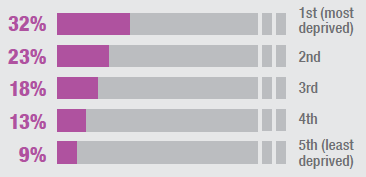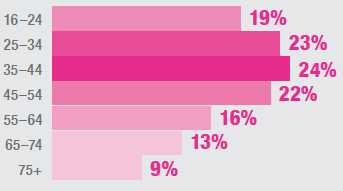Scottish Health Survey 2018: summary report
Key findings from the Scottish Health Survey 2018 report.
Chapter 4 Smoking
19% of adults smoked in 2018. This was not significantly different to 2017, but the rate has fallen significantly since 2003 (28%).
The percentage of adults who had never smoked regularly or at all was at its highest level in 2018 at 59%. The figure had risen from 50% in 2003 to 55% in 2011 and since then had remained fairly stable (54–56%) until the increase in 2018.
There has been a steady decline over time in the mean number of cigarettes smoked per day by current adult smokers; in 2003, the average was 15.3, falling to 11.8 per day in 2018.
17% of women reported they currently smoked in 2018, down from 28% in 2003.
21% of men reported they currently smoked in 2018, down from 29% in 2003.
The mean number of cigarettes smoked per day among current smokers increased with age, from 7.8 among those aged 16-24 to 16.2 among those aged 65-74; there was a subsequent decline to an average of 13.3 cigarettes per day among those aged 75 and over.
Women smoked on average 10.8 cigarettes per day in 2018, down from 14.7 in 2003.
Men smoked on average 12.7 cigarettes per day in 2018, down from 15.9 in 2003.
In 2018, adults living in the most deprived areas continued to be around 3 times more likely to smoke than those in the least deprived areas.

Current smoker prevalence was highest among those aged 25-54.

As in every year since 2015, the proportion of current e-cigarette users in 2018 was 7%, having increased from 5% in 2014.
- 2018 7%
- 2014 5%
The prevalence of e-cigarette use was highest among the middle age groups (8-11% among those aged 25-54) and lower for the youngest (5% among those aged 16-24) and older adults (1-6% for those aged 55 and over).
In 2018, a higher proportion of men than women reported currently using e-cigarettes; in previous recent years there had been no significant difference between the sexes (in 2016 and 2017 7% of both men and women were current users).
- 6% of women used e-cigarettes.
- 8% of men used e-cigarettes.
The proportion of current e-cigarette users who were also current regular smokers was significantly lower in 2017/18 combined (42%) than in 2014/15 combined (60%).
In 2018, among ex-smokers or those who had attempted to stop smoking, 27% had used nicotine gum, nicotine patches, a nasal spray/nicotine inhaler or lozenges/microtabs, around a fifth (18%) had used an electronic cigarette/vaping device and 5% had used prescriptions of Champix/Valenicline or Zyban/Bupropian in their most recent attempt to quit. Over half (59%) had not used any Nicotine Replacement Therapy (NRT) or other product in their attempt to quit.
The percentages of adults who had used these types of NRT or other product and found that they helped them to successfully stop smoking for a month or more were:
- Nicotine gum, nicotine patches, nasal spray/ nicotine inhaler or lozenges/microtabs 51%
- Champix/Valenicline 67%
- Electronic cigarettes/vaping devices 59%
Contact
There is a problem
Thanks for your feedback